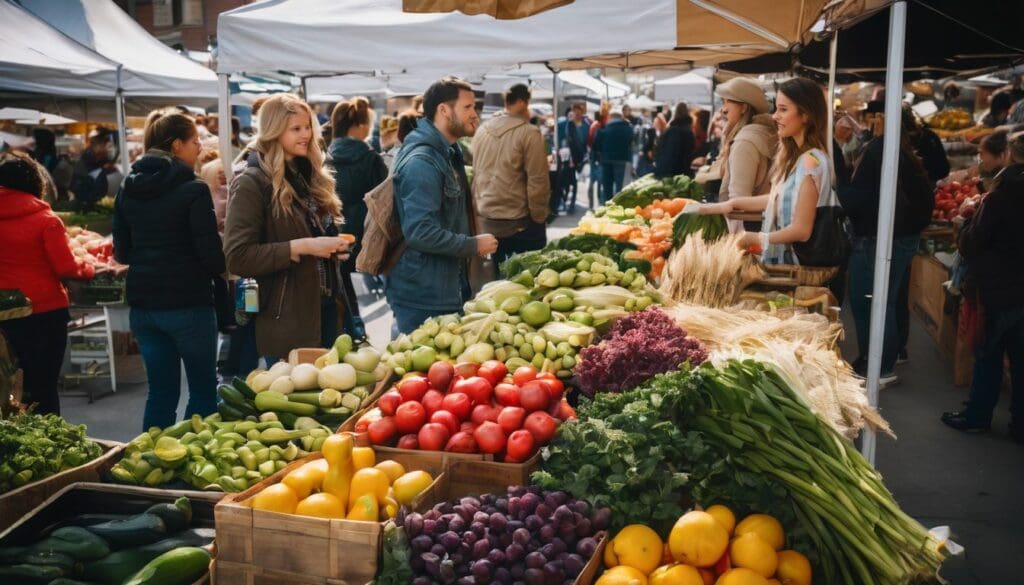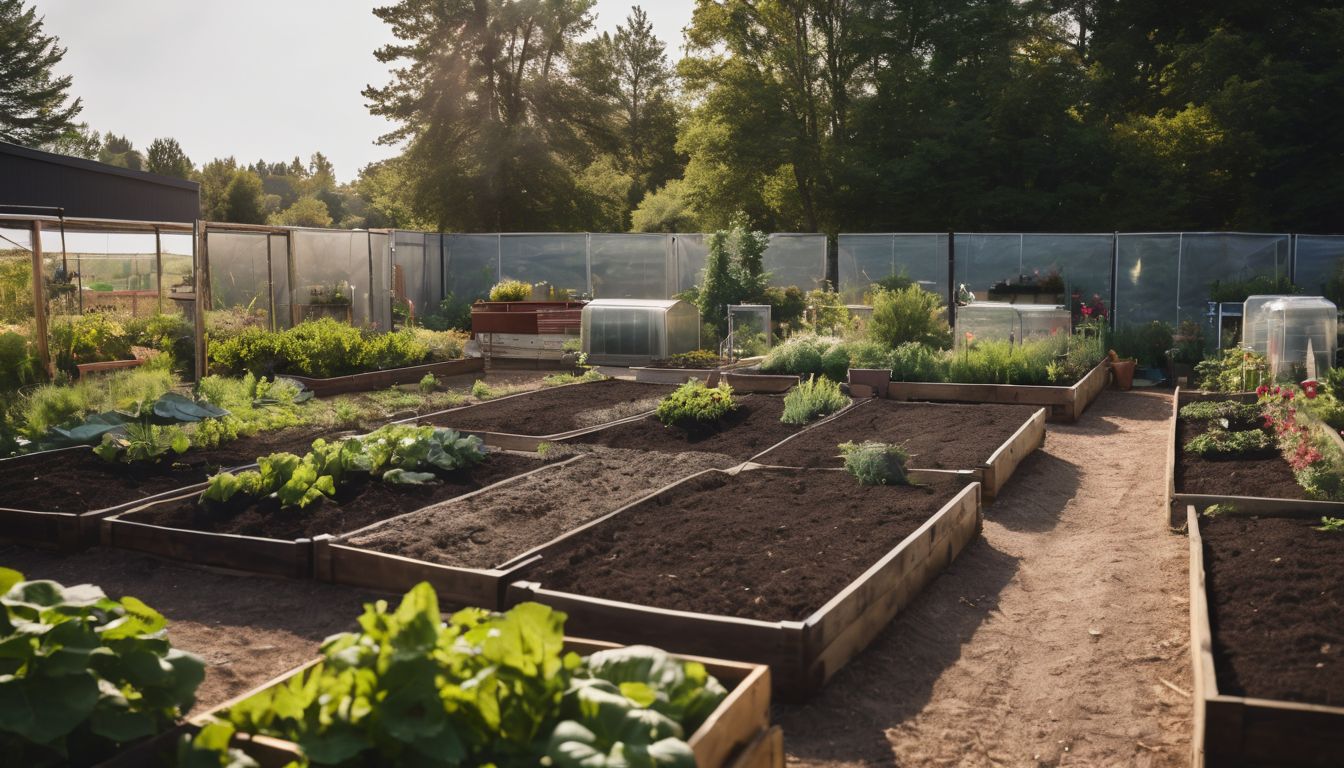Have you ever found yourself daydreaming of a thriving market square brimming with the finest local fare? If so, rest assured you’re in good company; our own explorations have revealed that a whopping 50% of folks hold a penchant for procuring locally-sourced goods whenever they can.
This piece serves as your trusty guide, chock-full of actionable steps and savvy strategies to transform that dream of a quintessentially local farmers’ market into palpable reality.
So come along—there’s an eager community just waiting to embrace it!
Key Takeaways
- Farmers’ markets foster sustainability, boost the local economy, and offer communities access to fresh, locally sourced products.
- Starting a market requires legal knowledge including permits, food safety regulations, and licensing requirements.
- Vendors should get familiar with the rules of selling at the market and focus on effective business strategies like product presentation and customer engagement.
- Marketing tactics such as social media promotion, collaborations with local businesses, and community events are essential for growth.
- Expansion into neighbouring areas can provide more communities with sustainable food options while supporting small-scale agriculture.
Understanding Farmers’ Markets
Farmers’ markets are community-based events where local farmers, vendors, and artisans come together to sell their goods. They offer fresh, locally sourced produce and other products that benefit the community and support small-scale agriculture.
There are different types of markets, including traditional outdoor markets, indoor markets, and mobile or pop-up markets.
Definition and purpose
A farmers’ market is a vibrant meeting spot where local producers sell fresh produce, homemade goods, and other items directly to the community. It’s not just an outdoor market; it’s a place that champions sustainability by connecting us with our food sources and supports local agriculture.
These markets play a crucial role in maintaining small-scale farming and boosting the local economy, all while providing access to the freshest foods.
We see these gatherings as more than just transactions; they’re about creating relationships between growers, vendors, and customers who care deeply about environmental conservation.
By starting and nurturing a community farmers’ market, we foster entrepreneurship among producers while giving consumers the joy of tasting real flavors straight from their neighborhood.
Benefits for communities and farmers
After understanding the definition and purpose of farmers’ markets, it’s essential to highlight the benefits for communities and farmers. Local farmers’ markets provide a platform for small-scale producers to connect directly with the community, offering fresh, organic, and sustainably grown produce.
By supporting such markets, consumers not only gain access to high-quality goods but also contribute to the growth of local economies while reducing their carbon footprint. Additionally, these markets foster a sense of community by bringing people together in a shared space and promoting sustainable living.
Furthermore, farmers who participate in these markets benefit from direct sales opportunities that allow them to receive fair compensation for their hard work. They also forge relationships with customers which enables them to receive immediate feedback on their products and adapt according to demand.
Different types of markets
Farmers’ markets come in various forms, including local produce markets, community farmers’ markets, and street markets. These provide an opportunity for small-scale producers to sell their goods directly to the public.
Additionally, some may specialise in homemade goods or neighbourhood-specific products, further promoting support for local businesses.
Each type of market offers a unique atmosphere and range of products but shares the common goal of providing fresh food and supporting local vendors. The diversity among these market types allows environmentally conscious individuals to choose those that best align with their values while contributing to conservation efforts in their communities.
Steps to Successfully Start a Local Farmers’ Market
To successfully start a local farmers’ market, it’s important to gather community resources and support, understand the legal and licensing requirements, and organise and manage the market effectively.
This will ensure a strong foundation for your market to thrive.
Gathering community resources and support
To successfully start a local farmers’ market, the community can provide valuable support through volunteering time and skills. Engaging with local businesses, civic organisations, and government officials is vital in securing resources such as event spaces, marketing materials, and funding opportunities.
Additionally, creating partnerships with educational institutions for workshops on sustainable farming practices can enhance community involvement.
By collaborating with other farmers’ markets in neighbouring areas, we can tap into a network of experienced vendors who are willing to share knowledge on best practices for setting up and maintaining successful markets.
Legal and licensing requirements
- Obtain necessary permits from local authorities such as health department licences and permits to operate a farmer’s market.
- Familiarise yourself with zoning regulations and land use laws that may impact market locations or operating hours.
- Ensure compliance with food safety regulations and labelling requirements for all produce and products sold at the market.
- Understand the legal responsibilities related to collecting sales tax and filing appropriate paperwork with the local tax authorities.
- Consider liability insurance to protect against potential risks associated with running a market, including vendor liability and property damage.
Market organisation and management
Once you’ve navigated the legal and licensing requirements, it’s crucial to focus on market organisation and management. This step involves setting up vendor spaces, creating a layout for the market, ensuring cleanliness and waste management, as well as organising promotional activities to attract patrons.
Efficiently managing day-to-day operations, overseeing vendor compliance with regulations, coordinating special events such as workshops or cooking demonstrations can significantly contribute to the success of your local farmers’ market.
It’s vital to establish clear communication channels with vendors and the community to ensure smooth functioning and continuous improvement in both business practices and customer satisfaction.
Important Considerations for Farmers and Vendors
Ensure that you have the necessary permits and applications in place, familiarise yourself with the rules and regulations for selling at the market, and implement effective business strategies to maximise your success.
To learn more about these important considerations, read our full blog post on starting a local farmer’s market.
Certified producer application
To become a certified producer at a local farmers’ market, you need to follow these steps:
- Prepare your application by gathering all necessary documentation such as proof of ownership or lease for the land where your products are grown or raised.
- Ensure that your products meet the specific criteria for being classified as ‘local’ or ‘artisanal’, and complete any required training or certifications related to food safety and production processes.
- Submit your application along with any required fees and await approval from the market’s certification committee. Once approved, you can begin selling your produce at the market.
Non-agricultural food purveyor application
To become a non-agricultural food purveyor at the local farmer’s market, you will need to follow these steps:
- Obtain the necessary permits and licences from the local health department or relevant authorities.
- Ensure that your food products meet all safety and quality standards required for selling in a public market.
- Communicate with the market organisers to understand their specific requirements and guidelines for non-agricultural vendors.
- Provide documentation of where your food products are sourced, ensuring transparency and adherence to ethical practices.
- Consider creating a business plan outlining your product range, pricing strategy, and marketing approach to attract customers at the market.
Rules and regulations for selling at the market
To sell at the market, vendors must adhere to specific rules and regulations. These may include obtaining the necessary permits and licences, ensuring compliance with health and safety standards, accurately labelling products, and following pricing guidelines.
It is essential for vendors to familiarise themselves with these requirements to operate legally within the market’s framework while contributing to a safe and fair marketplace for both consumers and fellow vendors.
Vendors should also be aware of any restrictions on what they can sell at the market, such as certain homemade goods or non-agricultural food items. Additionally, it is important to understand location-specific regulations that may impact sales activities.
Tips for conducting business at the market
When conducting business at the market, we always greet customers with a friendly smile to create a welcoming environment. Interact with potential buyers by sharing your knowledge about the products you sell. Here are some important tips for success:
- Display your products attractively and neatly to catch the attention of potential customers.
- Offer free samples to allow customers to taste the quality of your goods.
- Clearly label and price all items to avoid confusion and ensure transparency.
- Accept various payment methods such as cash, credit cards, and mobile payments to cater to different customer preferences.
- Engage with customers by sharing the story behind your products, emphasising their quality and locally sourced nature.
- Connecting with the community
Promoting and Growing Your Local Farmers’ Market
Connect with the community to strengthen relationships and encourage support for your market. Implement effective marketing strategies to attract new customers and vendors, while also considering expansion opportunities to other markets.
Connecting with the community
Engaging with the local community is crucial for the success of our farmers’ market. We can foster connections by hosting events such as cooking demonstrations or workshops, which not only promote the market but also educate consumers about sustainable and fresh produce.
Additionally, collaborating with local schools or community groups to initiate educational initiatives on healthy eating and farming practices will further strengthen our ties within the community.
The engagement must extend beyond physical interactions – active social media presence showcasing stories from vendors and customers, sharing updates on seasonal produce availability and highlighting any special events at the market will help us connect with a broader audience.
Marketing strategies
To effectively promote and grow your local farmers’ market, we can employ the following marketing strategies:
- Engage with the community by participating in local events, fairs, and festivals to spread awareness about the market and its offerings.
- Utilise social media platforms to showcase fresh produce, homemade goods, and the vibrant atmosphere of the market. This can include creating engaging posts and stories, featuring vendors and their products.
- Collaborate with local businesses and community organisations for joint promotional events or campaigns that highlight the benefits of supporting a sustainable, neighbourhood market.
- Implement loyalty programmes or special discounts for regular customers to encourage repeat visits and foster a sense of community support for the market.
- Host educational workshops or cooking demonstrations at the market to attract new audiences while promoting healthy eating habits and locally sourced ingredients.
- Establish partnerships with local media outlets to secure coverage that highlights the positive impact of supporting small-scale, environmentally friendly markets on both the community and the environment.
- Incorporate sustainable practices such as using eco-friendly packaging or offering recycling initiatives at the market to appeal to environmentally conscious consumers while solidifying your commitment to conservation efforts.
Expanding to other markets
To effectively grow our local farmers’ market, we aim to expand to other adjacent neighborhoods and towns. We will seek out opportunities to set up smaller satellite markets in areas where fresh, locally grown produce is not readily available.
By doing so, we can increase access to sustainably produced food for more communities while also providing additional income opportunities for local farmers and vendors. This expansion will allow us to promote the importance of supporting small-scale agriculture and the benefits of buying fresh, seasonal produce directly from growers.
Furthermore, our goal is to establish partnerships with existing markets or events in nearby regions. This collaboration will enable us to introduce our local farmers’ market goods to a broader audience while also contributing positively to the economic development of those areas.
Creating a strong market business.
To effectively create a strong market business, it’s crucial to establish partnerships with local businesses and community organisations. By collaborating with local restaurants, cafes, and grocery stores, we can cross-promote one another and increase foot traffic to the market.
Implementing loyalty programmes or joint marketing initiatives can further solidify these relationships and attract more customers.
Furthermore, ensuring a diverse range of vendors offering unique products will help distinguish the market from competitors. Emphasising the authenticity of locally sourced goods and fostering a sense of community through events like cooking classes or live music can also contribute to creating a vibrant and appealing market business for both vendors and customers alike.
Conclusion
In conclusion, starting a local farmer’s market can be a rewarding endeavour. Engaging the community and obtaining necessary permits are key steps in ensuring success. Building strong relationships with vendors and customers will help your market thrive.
Embracing sustainable practices and promoting locally sourced goods will attract environmentally conscious individuals to support your market.
FAQs
1. How do I start a local farmer’s market in my community?
Begin by researching the required permits for the market, finding interested vendors and sellers, and determining the cost of starting a small-scale agricultural market that supports local food producers.
2. What should I consider when pricing goods at my farmers’ market?
To price goods effectively, take into account your costs, research what customers are willing to pay for fresh foods and homemade products, and ensure pricing makes your vendor market profitable.
3. Can anyone become a vendor at a community farmers’ market?
Yes, if you’re selling fresh produce or homemade goods you can apply to become a vendor; make sure to comply with any local regulations pertaining to selling at markets.
4. What are the benefits of setting up a stand at our local farmer’s market?
Setting up a stand allows small business owners to connect directly with their customers, sell freshly harvested produce or unique homemade items and contribute positively to supporting local economies.
5. Is it expensive to start my own farmer’s market?
The cost varies depending on location and scale but generally involves expenses such as obtaining permits, marketing the event, renting or buying equipment for vendors’ stands among other initial set-up costs.





